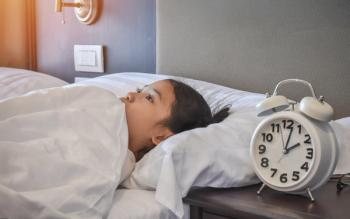
Newer Agents for the Management of Narcolepsy
Richard K. Bogan, MD, FCCP, FAASM, and Asim Roy, MD, comment on the evolving treatment landscape for narcolepsy and patient selection of FDA-approved agents: solriamfetol, pitolisant, and lower-sodium oxybate.
Episodes in this series

Richard K. Bogan, MD, FCCP, FAASM: I know you’re going to talk about solriamfetol as an option. It was developed primarily to meet an unmet need. These individuals are still sleepy, and not all medications work satisfactorily. Tell me about solriamfetol.
Asim Roy, MD: That came into the mix around the same time as pitolisant. It’s a dopamine norepinephrine reuptake inhibitor. If we think about other drugs and mechanisms of action, bupropion is probably the closest in terms of mechanism of action that solriamfetol is similar to. Probably the only tweak or difference is the nicotinic receptor that bupropion has an effect on but solriamfetol does not. Otherwise, it has shown to be a potent alerting effect. It’s not for everyone, but in patients who respond well, it has a long duration of action. A lot of times with stimulants, especially short-acting stimulants, you have to dose these individuals 2, 3, sometimes even 4 times a day to give them 2- or 3-hour chunks of alertness. If we can provide therapy once in the morning that can sustain them for 9, 10, or 11 hours, that has some huge positive compliance benefits, Patients also prefer something that’s smoother throughout the day. This is where pitolisant also has a long duration of action. Armodafinil, the sister version of modafinil, has a little longer duration of action. These are the therapies that can be given in the morning and that can hopefully sustain an individual throughout most of the day.
When we look at the oxybate world, this is the only nighttime therapy that targets GABAB receptors in the brain. The orexin system maintains that wakefulness, but as it decreases in the evening or at night, the GABA system takes over to put the brain to sleep. Oxybate targets GABAB. When we think of benzodiazepines, traditionally they work on GABAA and GABAB but potentially a little more on GABAA. There are only a few that are selective to that GABAB receptor, which we believe helps stabilize sleep. It works in these individuals with narcolepsy and idiopathic hypersomnia, which was a recent FDA approval, using a low-sodium oxybate version.
Richard K. Bogan, MD, FCCP, FAASM: One other comment about solriamfetol, and then I want to ask you, how do you decide which 1 you’re going to use in your patients? It’s worth pointing out that in the clinical trials, when we looked at the Epworth Sleepiness Scale score, and we looked at the MWT [maintenance of wakefulness test], which is the MSLT [multiple sleep latency test] backward. Instead of telling them to fall asleep, we tell them to stay awake, and we measure. The effect size with solriamfetol was impressive in terms of the Epworth score, as well as the maintenance of wakefulness test, and it’s renally excreted. Some drugs are metabolized through the liver, and some will interfere with birth control pills. I’m sure you’re going to talk about that. Solriamfetol is 1 of the main drugs that doesn’t have an effect on oral contraceptives. It doesn’t enhance the safe enzyme system that has an effect on neural contraceptives. That’s something we take into account when we decide what therapy we’re going to use. How do you decide what to use?
Asim Roy, MD: The payer world, the insurance world, is going to dictate some of our pathways despite what we might feel is a better choice or something we’d like to start with. Traditionally, modafinil and armodafinil is where we’ll end up starting with the generic. They’re effective, but they’re liver metabolized. They have some drug-drug interaction with the oral contraceptive. We’ll have to counsel our patients about that, but it’s invariably something that we’ll need to consider as our first-line agent.
Once we’re past that point, meaning they’ve tried it and it might be helping them a little, or they’re not seeing a big response, our goal is to introduce a second agent. I decide that based on symptomatology. If they have cataplexy, I’ll go after the anticataplectic therapies more aggressively and a little sooner. That’s going to be a decision between pitolisant or an oxybate. That’s an open discussion with the patient about the mechanism of how they work. What’s the value of using 1 over the other? What are the advantages of doing something in the daytime? What’s the advantage of doing something at night? Maybe we may need to consider both down the road. That’s the discussion. If they have type 1 narcolepsy after a modafinil failure or armodafinil not responding as well, I’ll try to go after anticataplectic therapy.
However, for most other patients—type 2 narcolepsy and IH [idiopathic hypersomnia]—we’re going to be considering a stimulant at this point, or I’ll consider solriamfetol. The discussion is that for 50% to 60% of our patients, at least in our clinic, modafinil or armodafinil didn’t work. Solriamfetol still has a great chance of working in that patient pool. It’s an option that’s worth considering if we can stave off a stimulant. Our philosophy is starting to move away from stimulants as much as possible, but it’s hard to avoid completely. If we can get to a point where they’re using only as needed—driving, afternoon meetings, situational—then it’s an ideal scenario in my book, but some patients can’t avoid relying on stimulants. It’s going to be a wake-promoting agent, which is modafinil, armodafinil, or solriamfetol, and then most likely a stimulant. In that discussion afterward, pitolisant and oxybate come up as a close third. It’s a 1-on-1 discussion with the patient on which of these seems best. Based on their lifestyle and situation at home, 1 may be more advantageous than the other.
Richard K. Bogan, MD, FCCP, FAASM: There are a lot of chefs who have different recipes, but your outline is entirely appropriate. In my clinic, with stimulants, the problem is tolerance and adverse effects. We’re all intrinsically sleepy in the afternoon; it’s siesta time. These patients are already sleepy, and then you add that on top of it. It’s not unusual for us to use a little rescue methylphenidate in the afternoon to get them over the hump. Because if they can get it over the hump and get into the evening hours, then sometimes they’re doing better. But I agree with what you’re saying.
Transcript Edited for Clarity
Newsletter
Receive trusted psychiatric news, expert analysis, and clinical insights — subscribe today to support your practice and your patients.

















